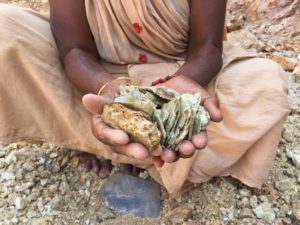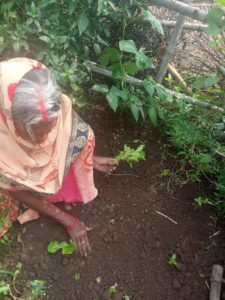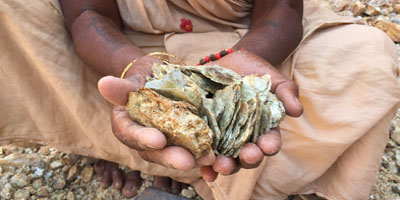On a typical day in Jharkhand, a province in the northeast of India, a family joins most of the people of their village sets off to an old mine site, while in the arid south of Madagascar, a young mother brings along her children, including toddlers, to join people scavenging the same mineral, mica.
These families work long hours in the hot sun for a low wage, or perhaps even just the hope of paying off a debt to the mine owner. They are most likely working illegally, with no workers’ rights to speak of, and living in rural areas characterized by political instability and a lack of infrastructure. Even if they are fortunate enough to not rely on their children’s financial input, schools may not be accessible or may lack staff, so they have to bring their children to the mines. In many ways, they have been forgotten by their countries’ governments, and those who buy the goods that are made with the mineral have no idea who they are.
Children are especially vulnerable to the risks associated with working in illegal mines. Younger children who sort through mica with their mothers are often not provided with gloves or masks. This exposure to dust is known to cause skin conditions, as well as lasting breathing difficulties and lung disease. Older children may have to enter mines and help to transport pieces of the mineral, and are at risk of being caught in a collapse. All work long hours and are often completely unable to attend school. In Madagascar, sexual exploitation of young girls in mining communities has also been found to occur due to the relative wealth and power of the mica traders that come through their villages.

In Jharkhand and Bihar, mica is often hand-picked with simple tools in areas where the surface soil is abundant. This work can be done both by men and women, on abandoned mines around their villages. All photos courtesy of the Responsible Mica Initiative.
To better understand the scope of the problem of child labour in India and Madagascar’s mica mines, I spoke with organizers from multiple nongovernmental organizations.
Fanny Fremont is the executive director of the Responsible Mica Project, an organisation which connects corporations, governments, and non-profit organisations in an effort to eradicate child labour in Indian mica mines.
Jos de Voogd is the press officer for Terre des Hommes Netherlands (TDH), a human rights NGO that has commissioned studies on child labour in both India and Madagascar.
Nagasayee Malathy is the executive programs director of the Kailash Sathyarthi Children’s Foundation, an Indian NGO dedicated to child welfare which supports anti-trafficking, child labour and child poverty initiatives countrywide.
An alarming proportion of workers in mica are underage. In 2015 there were an estimated 22,000 children working

in India’s mica mines. In 2018, TDH estimated that half of the 20,000 mica miners in Madagascar were children.
Child deaths related to the sector have also been recorded. In 2017, a government investigation in Jharkhand found that at least seven children died in mica mines in a three-month period. However, actual numbers are
likely to be higher. Thompson Reuters reported in 2016 that mine operators and workers themselves attempt to cover up deaths to avoid a crackdown on mines, which could result in a loss of income for their entire communities.
Parents may need to bring their children with them to the mines to work, despite the risks involved. Fremont says that these families are forced to depend on the extra income their children can bring in. “Child labour is the consequence of the raging social and economic challenges that local population are facing to maintain their livelihood. It’s a mix between an important level of poverty and a lack of education, infrastructure and teachers. This leads to children accompanying their parents to the mine areas, and starting to dig with them, and then it becomes a habit.”
The mica supply chain
Mica is a crumbly, shiny rock that has many industrial uses. Even though you may never have heard of it, you have definitely bought something containing it. In fact, you are probably using a device with mica in it to read this. In sheet form it is a mainstay in electronics, used in semiconductors as an insulator. Cosmetics and paint companies use it in the form of scrap mica to impart a sheen to their products. Construction and automotive industries also use it as a lubricant and filler. Although used in small amounts, the mineral is ubiquitous in the products we use every day. If you drive a car, use a cell phone, or wear cosmetics, you have consumed mica. The list of companies implicated in the mica supply chain is massive, due to the amount of processing it goes through. Unilever, Fujitsu, Estee Lauder, L’Oreal, Philips, Panasonic, and LVMH are just a few of the companies confirmed to source mica from India and Madagascar.
There are likely countless others who do not even know it is in their products.
 “When you confront the companies with the fact that there is mica in their product, and this mica comes from India and the chance of child labour is very large, they ask ‘what is mica?” de Voogd said. Speaking about companies’ responses to his group’s advocacy work in global mica supply chains since 2016, he said, “They didn’t know about mica and that it was in their products.”
“When you confront the companies with the fact that there is mica in their product, and this mica comes from India and the chance of child labour is very large, they ask ‘what is mica?” de Voogd said. Speaking about companies’ responses to his group’s advocacy work in global mica supply chains since 2016, he said, “They didn’t know about mica and that it was in their products.”
With China’s economic boom and an increase in the popularity of natural cosmetics favouring the use of non-synthetic materials, such as certain naturally-occurring minerals, in their products, the international demand for mica has grown massively over the past few years. As a result, those who harvest the mineral have been put under an international spotlight, many of whom live in either India or Madagascar. According to Terre des Hommes, 25% of the world’s mica supply, has been derived from the Indian provinces of Jharkhand and Bihar. Madagascar, on the other hand, is the leading exporter of sheet mica, mostly from its southernmost region.
In India, the Forest Conservation Act was passed in 1980 in an effort to curb deforestation, rendering all mines in forests (and thus, almost all mica mines) illegal. Although the Indian government has committed to begin legalising mica mines in 2017 after the scandal of the Jharkhand investigation, there has been little tangible progress.
In both India and Madagascar, mica mining is done illegally in small-scale, low-tech mines. In any industry, this is a recipe for the infringement of human rights, but even more so in labour-intensive and dangerous extractive activity where explosives are used and unregulated mines may collapse.
A context of poverty
The context in these two regions (before NGO and government intervention) was remarkably similar. Both are rural, difficult to access, politically unstable due to local insurgencies. Both lack of access to clean water, health services, and education. Southern Madagascar is the poorest region in a country with an already-low Human Development Index rating of 0.51, while Jharkhand and Bihar are some of the poorest regions in India.
In these mining communities, it is common for most, if not all, residents to be completely reliant on mica for survival, especially during the dry season. Due to an arid climate, lack of irrigation, and lack of access to high-quality seeds, agriculture is not a feasible means of subsistence year-round. As a result, these mining communities are at the mercy of traders and the larger companies that buy from them.
Miners do not receive a living wage and the price of the mica they sell to exporters is undervalued, due to their lack of leverage to negotiate prices. As with any illegal trade, it is difficult to pin down exact wages, but children may receive a few cents per day’s work, while adults can expect to make a few dollars per day (wages are higher for collection over sorting, but even then the maximum has been reported to be around 3 USD per day). After accounting for cost of living, these wages are barely enough for families to subsist on. In Madagascar, for example, most miners can only afford one meal per day.
Health expenses are another pitfall for miners. In a dangerous line of work such as artisanal mining, workers may have to take out loans to receive the care they need to continue working. According to a 2019 article by Peter Bengsten in The Diplomat, the widespread poverty in India’s mica communities creates the conditions for bonded labour in the mines where mine owners and mica traders collect interest rates that can reach more than 200 percent per year. These high interest rates are another layer of oppression that these communities face, and another obstacle in escaping a cycle of poverty.
The search for solutions
“We don’t want to call for a boycott of products with mica,” de Voogd said. “Mica is providing an income for the families; it’s only that they should stop bringing their children to the mica mines.” Freemont agrees, saying that a boycott would be a political and social disaster for these communities because they rely on it for subsistence, saying that, “Minerals are a development means for this country. So companies should stay but make sure they are sourcing mica in a responsible manner with respect to all human rights”.
Lush, an English cosmetics company, switched over completely from natural to synthetic mica in 2018, while responding to criticism about backing out of the market by arguing that its limited buying power as a smaller buyer would make their impact on mica demand relatively insignificant.
Although the situation seems bleak, there has been progress towards a mica supply chain that pays a living wage and is child labour free in India. Multiple nongovernmental organisations have been working in the region to improve the quality of life of mica workers.
One such NGO is the Kailash Satyarthi Children’s Foundation (KSCF), which has operated in Jharkhand and Bihar since 2005. Its director, Nagasayee Malathy, told me that before they started their work in the mica mining region, there were no roads or schools. Since then, she says, “Schools have been constructed, schools have been renovated, roads have been laid, and when it comes to the social side of it, in the villages where we have been working, we don’t see children going to work.”

From the Responsible Mica Initiative: “In many villages, school attendance is poor, and the quality of the curriculum and teaching skills is inadequate. RMI initiatives work to strengthen curricula, improve school management and classroom environments, develop school leadership and enhance teacher capabilities. The program also engages parents to reinforce the role they can play in their child’s education. RMI also supports a scholarship program, which targets those children who dropped out from schools or who are at risk of dropping out due to adverse family circumstances. The children are from poor backgrounds where the family is unable to cope with emergency needs.”
The KSCF aims to promote child-centric community development, where children elect leaders that are recognized by the village government as part of their decision-making. Children being able to voice their concerns has allowed for a cultural change in the villages, according to Malathy. “People were not aware of their rights,” she says. “They need to have a voice.”
The business response
With increased international attention to the issues surrounding India’s mica industry, multinational corporations have come under fire for using Indian mica in their products. Indian mica has become a source of controversy because most of it has been shown to have been collected in illegal mines. The Indian Bureau of Mines estimated that 82 percent of mica was harvested illegally in 2014, but even this is thought to be an underestimate.
In response, the Responsible Mica Initiative (RMI), a “do-tank” comprised of stakeholders in the Indian mica industry (including corporate end-users, processors, exporters, and civil society organisations) was formed in 2017 with the goal of eliminating child labour in Indian mica mines by 2022. Members include household names such as L’Oréal, Burt’s Bees, Chanel, and Merck KGaA.
Fanny Fremont, its executive director, described the approach as “holistic” and “multi-stakeholder,” citing its pillar program: 1) targeting workplace standards through training and audits, 2) empowering communities through improving nutrition and access to education, and 3) working with the government to increase accessibility to the free healthcare plans that the government offers and advocating for formalisation of the sector. The RMI also supports programs for income diversification by providing quality seeds, training, and access to markets so that agriculture is more viable.
In the wake of COVID-19’s worldwide impact, the RMI is continuing to support mining communities in Jharkhand and Bihar, Fremont said in an email. After the federal lockdown order on March 22nd, all mining and trading activities in the region were halted, and consultations began with local authorities to determine their action plan.
“Food security was the first concern,” Fremont said. The RMI established four community kitchens, delivering more than 20,000 meals to more than 1,000 people, she said. After fifteen days, the local government took over the administration of the community kitchens, and the RMI continues to assist communities by providing income-generating activities such as mask-sewing and gardening for the kitchens. As they wait for mines to be reopened, Fremont said that they were staying involved in mining communities and keeping in contact with local government so that programs could continue without delay as soon as mines are opened.
Ivo Zenz, Merck KGaA’s Head of Corporate Responsibility for Surface Solutions, said in a statement that the company joined the RMI because, “We do not tolerate child labor and advocate for safe working conditions for workers. We are convinced that joint efforts to set industrial standards for compliant mica sourcing are important and will support the sustainable production and trade of raw mica from India.”
Zens says that the company engages in regular inspections by employees and third parties, comprehensive announced audits, and unannounced check visits. In addition, Merck KGaA states that it has established direct relationships with suppliers, allowing for “formally defined working conditions” (i.e. using open-caste techniques and machinery), and goes beyond the local requirements.
Some companies have taken on the challenge to audit their supply chains independently. One such example is Daimler AG, the producer of Mercedes-Benz cars. Daimler has focused on creating a child labor-free supply chain for the paint they use on their cars, although supply of other potentially mica-containing parts was not discussed. Aline Meiser, Daimler’s International Business Communications spokesperson, cites their Human Rights Respect System as their guide for respecting human rights at an early stage in production, wrote in a statement that “As a matter of principle, we require our direct suppliers to vigorously pass on and monitor standards and contractual obligations relating to working conditions, human rights, environmental protection, safety, business ethics, and compliance within the supply chain.” This approach to supply chain transparency has been lauded by NGOs, including Terre des Hommes.
There are no electronics companies in the RMI, even though 26% of mica demand is from this sector (according to 2015 TDH figures). Philips, the electronics giant that produces everything from televisions to toasters, was at one time a member but has since pulled out. The company did not respond to a request for comment.
Consumers can also help to improve conditions in mining communities by raising this issue to companies directly. “Ideally, we would like consumers to step up to these companies and say ‘we want you to produce products without child labour, and that’s your responsibility’ ” de Voogd said. But due to the small quantities of the mineral that are often used, especially in appliances and electronics, consumers may not be aware that they are using products with mica in them. “As a consumer, you don’t see it, so you have to know it,” he said, “It’s difficult to be aware of it”
Change is coming in India
The result of the collective efforts by multiple stakeholders seems to have had a positive effect in India. “Now, as the RMI, we are working in 80 villages and 44 percent of the children which have been identified as out of school are now back to school on a regular basis, and we started one year back,” Fremont said. “We are very much on track.”
In 2019, India’s National Commission for Protection of Child Rights reported that just over 5,000 children were not attending school in the mica belt of Jharkhand and Bihar, down from the 22,000 child workers found by TDH four years earlier. The validity of comparing the number of child workers to the number of children out of school may be questionable, as some children may go to school part time, but the numbers remain promising. “The positive message is that our collective actions in the area are proving some success, but some children are still in mines,” Fremont said.
Low wages are still an obstacle, despite the social and infrastructural change that has transformed mining villages. Fremont says that a lack of focus on increasing wages and finding alternative incomes for families is an unsustainable approach. “If you are not finding an alternative for the families to replace the salary brought by the child, then it won’t sustain,” she said. “You can take a child out of the mine and bring him back to school, but you can be sure that he will be back in the mines if you do not find an alternative for the family.”
Wages are often still too low for families to live off the income of parents alone. When mines are illegal, as many mica mines are, the minimum wage is rarely adhered to. “You can even give more than a minimum wage” Malathy says. “Just give them enough in wages so that, you know, it takes care of their livelihoods, because the majority of them don’t have alternative options”. She also says that corporations should be paying more attention to taking care of workers’ health, by supplying gloves and other protective equipment for example.
But there are setbacks in Madagascar
There are doubts as to whether India’s improvements could be replicated in Madagascar. Although India’s progress may be seen as a roadmap for NGOs and governmental intervention in Madagascar’s mica sector, it is not so simple. Electronics companies, who use mainly the sheet mica that is exported from the country, are not committed to due diligence that corporations in other sectors have shown. TDH reported that 87 percent of Madagascar’s mica was shipped to China, and then the supply chain gets muddled.
“There is no company asking itself ‘Is this good or bad mica? Is there child labour involved, yes or no?’ There is no one asking any questions,” de Voogd says. “There is more poverty, the areas are more remote, and the facilities are even less than in India.”
Madagascar’s government has a less capacity than India’s. Monitoring the mica sector is the first step to tackling problems of child labour, but de Voogd notes that the Madagascar mica belt is in a so-called “Zone Rouge”, meaning that there is a high level of crime in the area. As a result, auditors and NGO workers are not able to access these areas. Government forces should step in to create a safer environment for aid workers, he says, as has been the case in India since 2005.
The experts all emphasized that these challenges can be overcome through the combined efforts of governments, corporations, and NGOs. “All the different stakeholders have a role to play,” Fremont said. “It’s not, for instance, a company’s responsibility to develop proper laws and unfold them, but the government’s. It’s not the company’s expertise to take children out of mines and bring them back to school and provide quality education. We really need to have, around the same table the governments, the NGOs, and, of course, the private companies to have this multi-stakeholder approach.”
Malathy agrees, saying, “People need to work together and collaborate, in terms of forming a network of stakeholders.”
There is always work to be done as long as there are children in mines, Malathy says. As COVID-19 brings on an inevitable economic downturn, she says that it is even more vital to ensure that children are not also the ones to bear the burden of its effects. “It is a crime. You are depriving a child from their childhood, where the child is supposed to be playing, going to school, having fun.”
Regarding children in school, this picture highlights one component under our Community Empowerment Program vertical, indeed Access to Quality Education (a pull factor to withdraw children from mines).
In many villages, school attendance is poor, and the quality of the curriculum and teaching skills is inadequate. RMI initiatives work to strengthen curricula, improve school management and classroom environments, develop school leadership and enhance teacher capabilities. The program also engages parents to reinforce the role they can play in their child’s education. RMI also supports a scholarship program, which targets those children who dropped out from schools or who are at risk of dropping out due to adverse family circumstances. The children are from poor backgrounds where the family is unable to cope with emergency needs.
Regarding mine site / mica collection: in Jharkhand and Bihar, mica is often hand-picked with simple tools in areas where the surface soil is abundant. This work can be done both by men and women, on abandoned mines around their villages.





